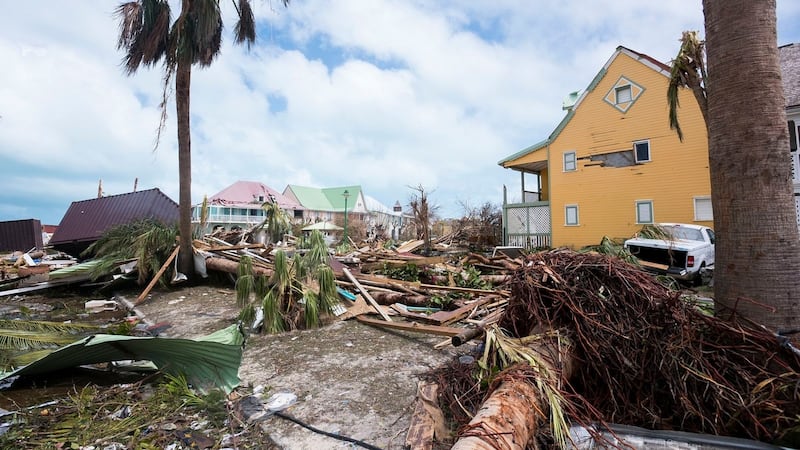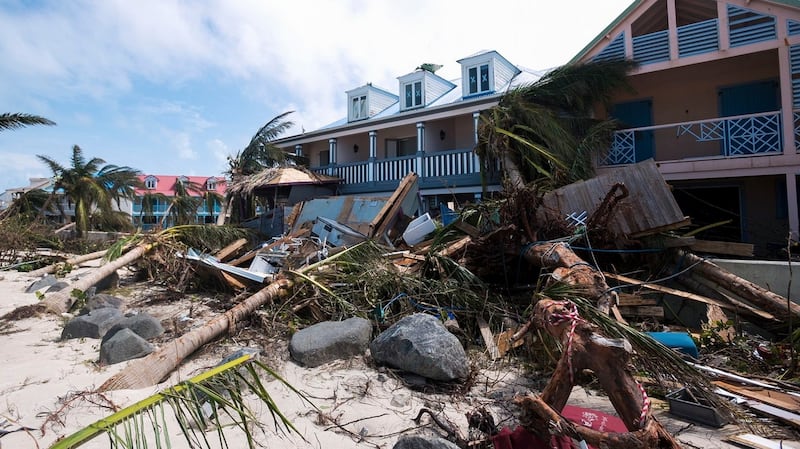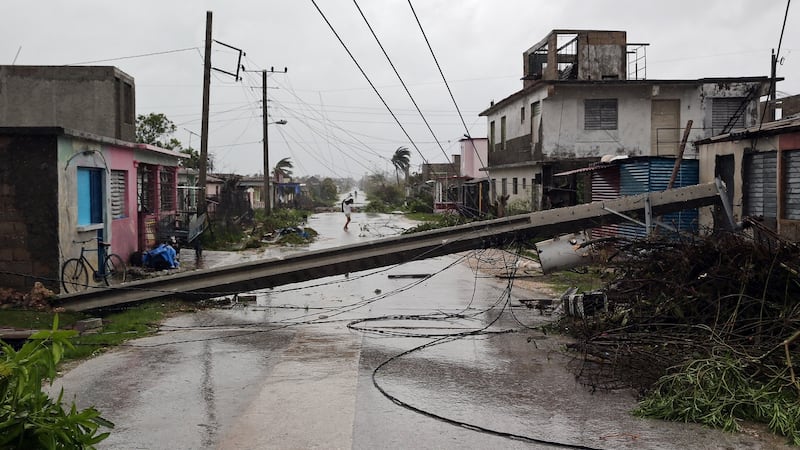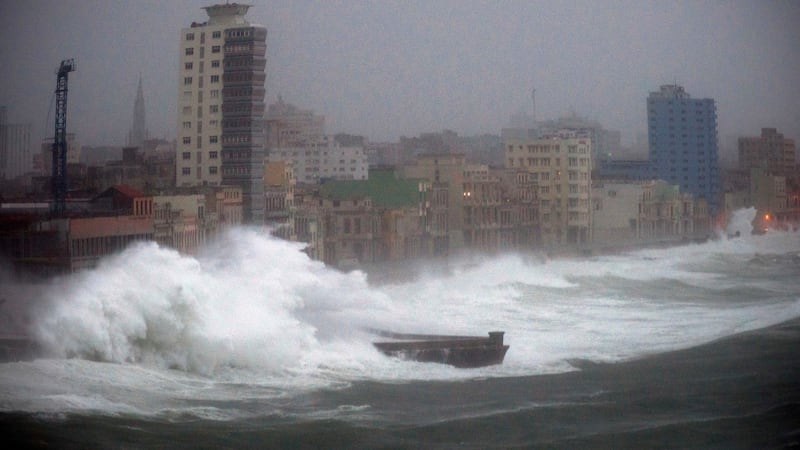Antigua and Barbuda
Barbuda, the first island to feel the force of Hurricane Irma was devastated by its high winds, with Gaston Browne, prime minister of Antigua and Barbuda, saying 90 per cent of buildings had been destroyed and 50 per cent of the population of about 1,000 people left homeless. Reports said that one islander had been killed.
The island is now a near-deserted disaster zone. Almost all of its 1,500 residents left for the sister island of Antigua, a 90-minute boat ride away, ahead of the arrival of Hurricane Jose.
“The biggest problem in Barbuda now is the fact that you have so many dead animals in the water and so on, that there is a threat of disease,” said the island’s foreign affairs minister, Charles Fernandez.
“You could put all the people back in Barbuda today ... but then you’ll have a medical crisis on your hands.”
One person - two-year-old Carl Junior Francis - is confirmed to have died in the storm. Michael Joseph, president of the Red Cross in Antigua and Barbuda, said, “the devastation is not like we’ve ever seen before - we’re talking about the whole country of Barbuda being significantly destroyed.”
Critical facilities including roads and communications systems were ravaged, with the recovery effort set to take months or years.
On Friday, authorities carried out a mandatory evacuation to the larger island of Antigua as Hurricane Jose, now a category four storm, approached. Jose, which the US National Hurricane Center said was “almost category five”, was due to hit the island on Saturday.
Anguilla
One person died in the British overseas territory, said Ronald Jackson, executive director of the Caribbean disaster and emergency management agency, who added that “police stations, hospitals, school facilities, three or four emergency shelters, a home for the infirm and the aged, as well as the fire station”, along with many homes, had been damaged or destroyed.
The UK foreign office minister, Alan Duncan, said: “The initial assessment is that the damage has been severe and in places critical.”
The tourist board said major resorts on the island had withstood the onslaught. The airport and two ports remain closed.
The island suffered more damage on Saturday from category-four Hurricane Jose. The storm forced the closure of airports and halted emergency boat traffic over the weekend.
The British government has been accused of a failure to respond speedily to the devastation. On Thursday, it announcedan extra £32m in aid and will send hundreds of marines and royal engineers, as well as HMS Ocean, currently deployed in the Mediterranean, which will take 10 to 14 days to reach the area.
St Kitts and Nevis
The prime minister, Timothy Harris, said St Kitts was “spared the full brunt” of Irma, but warned of “significant damage” to property and infrastructure, as well as power failures. The airport reopened on Thursday. A hurricane warning and flash-flooding watch have been discontinued, and residents and visitors given the all-clear. Jose was not expected to pass very close to the island.

St Martin and St Barthelemy
Eleven people have been killed, and more than 100 are injured in the French overseas collectivities of St Martin and St Barthelemy.
The French part of St Martin (the southern side, St Maarten, is administered by the Netherlands) was “95 per cent destroyed”, according to Daniel Gibb, a local official, who called it “an enormous catastrophe”.
“I have sick people to evacuate, I have a population to evacuate because I don’t know where I can shelter them.”
One person has been confirmed dead on the Dutch side of the island. The Netherlands prime minister, Mark Rutte, said there has been “enormous material damage” to the territory, and has sent marines and two aid flights.
France’s overseas minister, Annick Girardin, travelled to the Caribbean with emergency teams and supplies.
St Maarten, St Martin and St Barthelemy are all facing a fresh hit as Hurricane Jose heads towards the islands at the weekend.
St Martin’s 40,000-plus population have been evacuated to Guadeloupe. Women, children and the most vulnerable are receiving priority at the over-stretched airport on the French-run side of the island.
The US government deployed C-130s to evacuate Americans living on the island to Puerto Rico. About 160 were evacuated on Friday and approximately 700 more on Saturday.
The islands’ woes increased as the airport on St Barthelemy was closed, and those in Anguilla and St Martin were open only to the military, rescue crews and aid organisations.
Late on Saturday, St Maarten’s prime minister, William Marlin, said about 1,600 tourists had been evacuated and efforts were being made to move 1,200 more.
Mr Marlin said many countries and people have offered help to St Maarten, but authorities are waiting on the weather conditions to see how this can be coordinated.

Virgin Islands
Four people were reported to have been killed in the British Virgin Islands and the National Emergency Operations Centre was destroyed. The governor, Gus Jaspert, declared a state of emergency and said he was heartbroken by reports of the deaths. Many roads have been blocked and communication is limited, Mr Jaspert said.
Officials have flagged security issues on the islands, warning that instances of looting and robbery had been reported.
Natalie Drury, a resident of Tortola, the biggest of the British Virgin Islands,
told the Guardian: “We desperately need help as soon as possible. Food, water, shelter. I’m extremely concerned about health and safety - there is sewage absolutely everywhere.” Ms Drury confirmed that there had been widespread looting in the wake of the storm.
Some residents had been evacuated from the Virgin Islands archipelago. The amphibious assault USS Wasp evacuated hospital patients from St Thomas to St Croix and Puerto Rico. The Norwegian Cruise Line used one of its ships to evacuate 2,000 tourists from St Thomas in the US Virgin Islands.
The Caribbean disaster agency added that the airport was still operational but the control tower “has been compromised”.
Alan Duncan said: “The British Virgin Islands were not spared the hurricane’s full force. Our initial assessment is of severe damage and we expect that the islands will need extensive humanitarian assistance, which we will of course provide.”
Sam Branson, son of Virgin founder Richard Branson - who saw out the storm in a bunker on his private island of Necker in the BVI - said a lot of buildings had been destroyed.
Four people are confirmed to have died in the US Virgin Islands, with a government spokesman predicting the toll would rise. Donald Trump has declared a state of emergency and a major disaster. There were reports of extensive damage to buildings, and of land entirely stripped of vegetation.

Puerto Rico
Lashing winds and rains have left more than a million people without power and tens of thousands without water. Images from the island showed flash flooding, and hospitals were forced to rely on generators.
Three people - two women and a man - have been confirmed dead, and rescuers are searching for the missing. Waves of up to 9 metres were reported. Several thousand people remain in emergency shelters.
Governor Ricardo Rossello has also declared a disaster in the tiny islands of Culebra and Vieques, to Puerto Rico’s east, which were hard-hit by the storm. So far there has been little information from the islands.
Dominican Republic
Pictures from the Dominican Republic - where Irma passed to the north - show widespread damage: flattened buildings, downed trees and power lines. The coastal resorts of Cabarete and Sosua were reported to have seen storm surges, and more than 5,000 people were evacuated across the country.
On Thursday, Juan Manuel Mendez, director of the centre of emergency operations, said people there should “not let down their guard - the worst isn’t over”.
Haiti
Irma continued its path across the north of Hispaniola - the island shared by the Dominican Republic and Haiti - taking down a key bridge between the two. Heavy rains thrashed the north coast and several areas lost power.
Two people were reportedly injured in the northern port town of Cap-Haïtien when a tree crashed into their home.
Officials had admitted they were not prepared for the onslaught and no mandatory evacuation orders were in place ahead of Irma’s approach. But reports from Cap-Haïtien so far suggest Haiti has been spared the worst effects of the category 5.
Turks and Caicos
Life-threatening wind, rain and a storm surge were expected in the islands on Saturday night after Irma pummelled the British territory on Thursday night with winds of 280kmh.
Electricity supplies had failed on Grand Turk, which meant water production was also out, governor John Freeman said.
The director of tourism in the Turks and Caicos, Ramon Andrews, is reported as saying there has been no loss of life on the territory. He added that all visitors were safe and accounted for.
The islands will receive part of a £42m relief fund announced by the foreign secretary, Boris Johnson. Funds will also go to the other British overseas territories of Anguilla and the British Virgin Islands.
“The UK government is doing everything it possibly can to help those affected by the hurricane,” Mr Johnson said.
Bahamas
The Bahamas escaped the worst of Irma’s wrath, with no casualties or major infrastructure damages reported despite several downed power lines, toppled trees, debris and roofs damaged.
The Bahamas prime minister, Hubert Minnis, said his government had evacuated people from six islands in the south to the capital, Nassau, in the largest storm evacuation in the country’s history. Airports have been closed.
Officials have warned that there could be delays in disaster relief, while some government agencies are cut off from communications.
Cuba
The centre of Hurricane Irma cleared the Cuban coast on Saturday night and entered the Florida Straits.
Irma made landfall - the first category five hurricane to do so in Cuba since 1924 - on the Camaguey archipelago, just off the northern coast, late on Friday local time, with wind speeds of 260kph.

Along Cuba’s northern coast, tourists were evacuated and residents of coastal towns told to move inland. More than one million Cubans were evacuated before the storm, according to local media, along with 10,000 foreign tourists from beach resorts. The disaster alert level was increased to maximum ahead of Irma’s arrival.
Florida
Irma was forecast to hit Florida early on Sunday and mandatory evacuation orders have been issued for Florida Keys and swaths of southern and coastal Florida. Some 5.6 million people have been told to leave - one quarter of the state’s population.
More than 170,000 homes and businesses in Florida have lost power, according to reports. The centre of Irma was about 145km southeast of Key West at just after 11pm local time on Saturday.
About an hour earlier, the The National Weather Service said the first hurricane-force wind gust had been recorded in the Florida Keys, as Irma inched closer to the state.
The centre of Irma was heading towards the Keys and had sustained winds of 193 kph.
Florida Power and Light said on its website that more than half of those outages were in the Miami-Dade area, where about 600,000 people have been ordered to evacuate.
The company has said it expects millions of people to lose power, with some areas experiences prolonged outages.
The company said it has assembled the largest pre-storm workforce in US history, with more than 16,000 people ready to respond.
More than half a million people in neighbouring Georgia have also been ordered to evacuate coastal areas.
Residents fleeing the storm were caught in huge tailbacks on northbound highways out of the state.
Floridians have been told to flee north as Hurricane Irma is bigger than the entire state, and forecast to spend around 30 hours crossing it, meaning no regions will be unaffected.
Guardian News and Media












